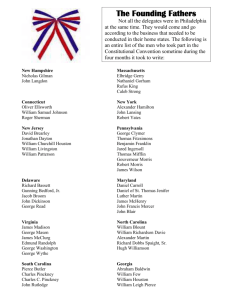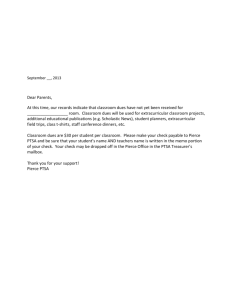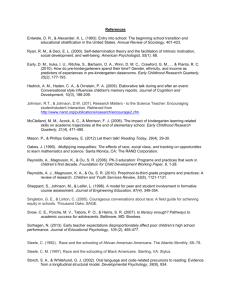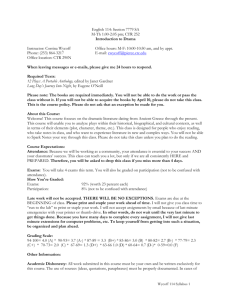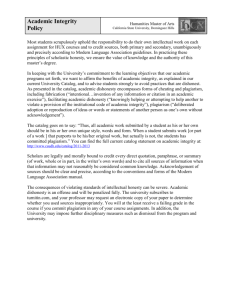Required Texts: - Texas A&M University
advertisement
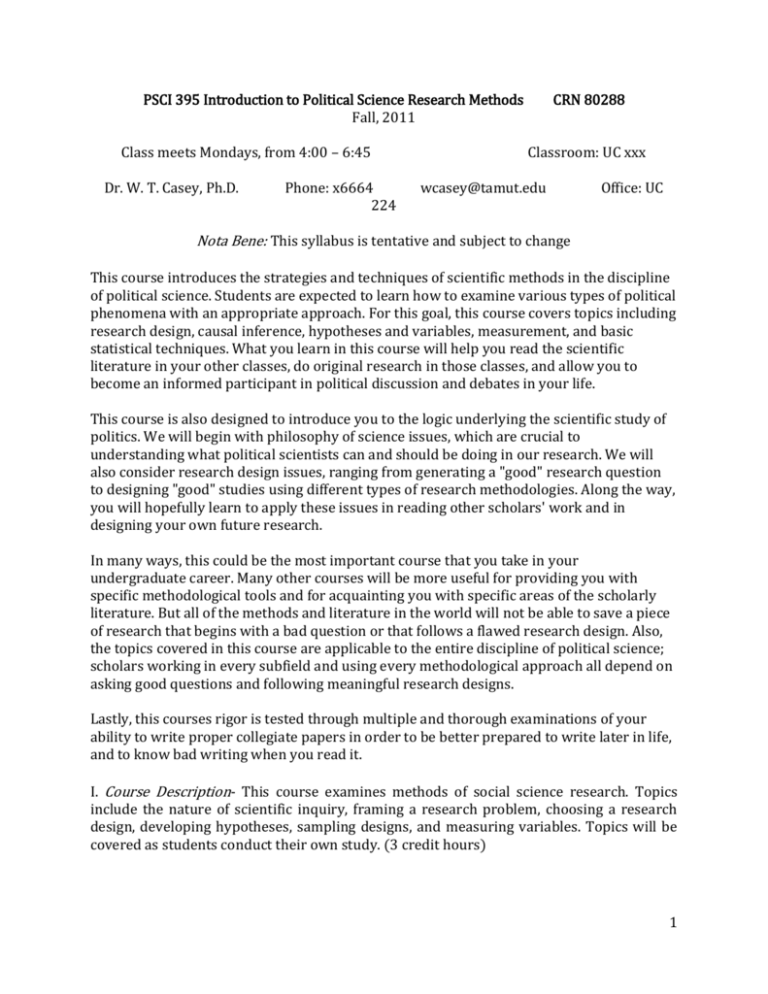
PSCI 395 Introduction to Political Science Research Methods Fall, 2011 Class meets Mondays, from 4:00 – 6:45 Dr. W. T. Casey, Ph.D. Phone: x6664 224 CRN 80288 Classroom: UC xxx wcasey@tamut.edu Office: UC Nota Bene: This syllabus is tentative and subject to change This course introduces the strategies and techniques of scientific methods in the discipline of political science. Students are expected to learn how to examine various types of political phenomena with an appropriate approach. For this goal, this course covers topics including research design, causal inference, hypotheses and variables, measurement, and basic statistical techniques. What you learn in this course will help you read the scientific literature in your other classes, do original research in those classes, and allow you to become an informed participant in political discussion and debates in your life. This course is also designed to introduce you to the logic underlying the scientific study of politics. We will begin with philosophy of science issues, which are crucial to understanding what political scientists can and should be doing in our research. We will also consider research design issues, ranging from generating a "good" research question to designing "good" studies using different types of research methodologies. Along the way, you will hopefully learn to apply these issues in reading other scholars' work and in designing your own future research. In many ways, this could be the most important course that you take in your undergraduate career. Many other courses will be more useful for providing you with specific methodological tools and for acquainting you with specific areas of the scholarly literature. But all of the methods and literature in the world will not be able to save a piece of research that begins with a bad question or that follows a flawed research design. Also, the topics covered in this course are applicable to the entire discipline of political science; scholars working in every subfield and using every methodological approach all depend on asking good questions and following meaningful research designs. Lastly, this courses rigor is tested through multiple and thorough examinations of your ability to write proper collegiate papers in order to be better prepared to write later in life, and to know bad writing when you read it. I. Course Description- This course examines methods of social science research. Topics include the nature of scientific inquiry, framing a research problem, choosing a research design, developing hypotheses, sampling designs, and measuring variables. Topics will be covered as students conduct their own study. (3 credit hours) 1 II. Student Learning Objectives/Outcomes. Upon completing this course students will be able to understand: why research in the social sciences is important; how research in the social sciences is designed and conducted; ethical issues in social science research; research concepts, allowing the student to engage in critical analyses of research in the social sciences. III. Prerequisites:. None- but take heed that this course is reading intensive, with substantial written components. Therefore, students must have competency in written and spoken English. Moreover, being that this is an PSCI core course, statistical competency is expected. IV. Required Textbooks- There are two (2) books required for this class: Pierce, Research Methods in Politics Schmidt, Writing in Political Science 1st ed. 4th ed. 978-1-4129-3551-7 0-205-61736-0 In addition, there are four (4) HIGHLY SUGGESTED books recommended for this course: Johnson & Reynolds, Political Science Research Methods , 6th ed. Katznelson &Milner, Political Science: State of the Discipline Salkind, Statistics for people who (think they) hate statistics, 2nd ed. Curd & Cover, Philosphy of Science, 1st ed. 1-56802-874-1 9780393051421 978-1-4129-7102-7 9780393971750 These should be available at the TAMUT bookstore, and you can probably buy a copy online somewhere as well. You are required to read ahead. Other useful readings: - Wonnacott, Thomas and Ronald Wonnacott. 1990. Introductory Statistics, 5th Edition. New York, NY: John Wiley and Sons. - Gravetter, Frederick and Larry Wallnau. 2004. Statistics for the Behavioral Sciences, 6th Edition. Belmont, CA: Thomson Wadsworth. - Knoke, David, George W. Bohrnstedt and Alisa Potter Mee. 2002. Statistics for Social Data Analysis, 4th Edition. Itasca, IL: F.E. Peacock. - DeGroot, Morris and Mark J. Schervish. 2002. Probability and Statistics, 3rd Edition. Boston, MA: Addison Wesley. V. Other materiél – as assigned VI. Office Hours – (TBA), and by appointment. VII. Attendance A. TAMUT requires "Regular and Punctual attendance". It has been my experience that poor attendance DOES result in a lackluster performance. Nonetheless, you are adults, so I feel no need to take attendance- Come only if you intend to learn. 2 B. Verification of Enrollment: TAMUT requires that all persons enrolled in coursework carry an identification card, and: 1) have on their person this card, and 2) be ready to surrender it for examination to any duly constituted authority. C. Tardies: Class is scheduled to begin at 4:00, thus, I will begin class at that time. There is not much leeway allowed due to the amount of material being covered. You are adults, you signed up for this class at this time. I will not repeat material for the benefit of those without the incentive to arrive promptly. If you know you will be late, please do your classmates the courtesy of not entering the room. Excessive tardiness will be penalized through your final grade. D. Leaving Early: Due to the amount of material being covered, leaving before class is complete iompedes comprehension. Moreover, doing so is an unnecessary breach of etiquette and a distraction to your colleagues. If you must leave early, inform me before class, or else your leaving will be treated as if a tardy and your grade will be penalised. VIII. Assignments A. Prior to class (excluding the first class, but including the final one), you will submit via e-mail from your TAMUT account 3 questions about the topical readings for that week. These are due no later than 5:00 p.m. the Friday before class. They are worth ten percent of your grade. B. Evaluating published research - Before designing and conducting your own research, it is often instructive to examine other scholars' published research. The first two written assignments for the course will involve detailed examination of two empirical articles from recent political science journals. Accompanying this syllabus is an outline of what these abstracts should include, as well as a sample abstract. You will be required to turn in your abstract of the article in question, as well as a photocopy of the article itself. These two abstracts will be due at the start of class on October 17th and November 7th. These are worth fifteen percent each, for thirty percent of your grade. The articles that you choose for these abstracts must be empirical analyses of some topic in political science. You should choose two recent articles from social science journals (e.g., the Journal of Conflict Resolution, or American Journal of Sociology, or American Journal of Political Science, or Public Affairs Quarterly, and so forth). You may choose articles from any of the journals in your field of social science, as long as the articles that you select make a theoretical argument, assemble evidence in support of or against that argument, and evaluate the results. If there is any question about whether or not an article is appropriate, you may photocopy the article or selected portions of the article to bring by my office. C. A Research Design on a modern puzzle in the social sciences in your major field. After learning what to look for in other scholars' research, you will have an 3 opportunity to develop your own research design on some topic that interests you. More details will be provided later in the semester. The research design will be due at the start of class on November 28th. More details later, but for now check out http://www.socialresearchmethods.net/ . This is worth thirty percent of your grade. D. Take-home final exam- The course will conclude with an in-class written final exam, which is meant to assess your understanding and integration of the topics covered through the entire semester. The questions for this final exam will be emailed the night before, and your answers will be written at the scheduled examination time for the course. More details will be provided later in the semester. This is worth thirty percent of your grade. E. You will also take the ETS Field Examination as part of the Political Science Program Assessment Process. All Majors in Political Science are required to take the exam. The date of the exam is November 21st, regular class time. XI. Participation – All students are expected to come to each class meeting prepared to discuss the readings. This will involve both spending the time to read each book or article on the reading list, and thinking about what each reading contributes to the weekly topic. For example, what are the main issues or questions addressed by a given week's readings? What does each reading for that week tell us about these issues and questions? What do you think about each reading's discussion of these issues, and where relevant, about the solutions that it offers? A. Student Participation is expected, and will be a consideration on your final grade. B. Course Etiquette and Classroom Conduct – TAMUT has rules and regulations for the orderly and efficient conduct of business. It is students responsibility to know the rules and regulations which govern student conduct and activities. General information on this may be found in the catalog, which is provided to all registered students each academic year. TAMUT administers student discipline within the procedures of recognized and established due process. Please consult your catalog, under “Student Code of conduct”. More specifically: We are all adults, at least legally. Adult behaviour is thus expected. Disrespectful language, gestures, shouting, insults, et cetera, is improper and will be handled through the Dean’s office, and most likely will result in a grade of F. 1. Turn off your cell-phones. Remove your iPods from your head. I reserve the right to expel you from the classroom if this turns out to be a persistent problem and your grade will be penalised. 4 2. No hats permitted to be worn while in the classroom, nor headphones. 3. I do not care if you eat or drink, simply do so quietly and unobtrusively. 4. No Laptops or electronic recording devices In other words: I fully expect you to behave as if you are mature, reasonable, sane people. C. WITHDRAWING FROM THIS COURSEIf you decide that you must drop the course, it is your responsibility to fill out the appropriate form in the college office on campus. Withdrawal from the course after the official day of record will result in a final grade of “W” on the student transcript and no credit will be awarded. Prior to the official day of record, it is the student’s responsibility to initiate and complete a request for withdrawal from any course. I do not automatically drop students. You do your own paperwork. If you stop attending class and do not fill out the drop form, you will receive an "F" in the course. XII. Grading – Standard 100-point scale, conformed to Letter grades. I DO NOT CURVE GRADES- such only rewards those lacking incentive to perform better, and punishes those who strive to achieve. Grading Scale: 90+ = A 80-89 = B 70-79 = C 60-69 = D Below 60 = F You will be assigned grades based upon your performance in your assignments. There is Extra Credit available, a handout explaining such will be made available later. Make-up Exams: There will be no make-up exams given without permission from the instructor – such permission will require a written legitimate – my discretion- excuse presented prior to the exam. Make-up exams will consist entirely of an oral examination before a jury of your peers. XIII. Disability Accommodations: Students with disabilities may request reasonable accommodations through the A&M-Texarkana Disability Services Office by calling 903-2233062. XIV. Academic Integrity and Scholastic Dishonesty – TAMUT is committed to a high standard of academic integrity in the academic community. In becoming a part of the academic community, TAMUT students are responsible for honesty and independent effort. The faculty expects from its students a high level of responsibility and academic honesty. Because the value of an academic degree depends upon the absolute integrity of the work done by the student for that degree, it is imperative that a student demonstrate a high standard of individual honor in his or her scholastic work. Failure to uphold these standards includes, but is not limited to, the following: cheating, plagiarism, collusion and/or falsifying academic records. Students suspected of 5 academic dishonesty are subject to disciplinary proceedings. Plagiarism, especially from the web, from portions of papers for other classes, and from any other source is unacceptable and will be dealt with under the university’s policy on plagiarism (see general catalog for details). This course will use the resources of turnitin.com (and other resources) for searches on the web for possible plagiarism. A. Some Definitions: 1. Cheating includes looking at or copying from another student's exam, orally communicating or receiving answers during an exam, having another person take an exam or complete a project or assignment, using unauthorized notes, texts, or other materials for an exam, and obtaining or distributing an unauthorized copy of an exam or any part of an exam. 2. Plagiarism means passing off as his/her own the ideas or writings of another (that is, without giving proper credit by documenting sources). Plagiarism includes submitting a paper, report or project that someone else has prepared, in whole or in part. 3. Collusion is inappropriately collaborating on assignments- such as exams and testsdesigned to be completed independently. These definitions are not exhaustive. B. With instructor permission only, magnetic tape audio recording devices may be used during lectures only for the purpose of helping students take notes. The use of such devices for any other purpose may result in loss of device use for remainder of semester, system charges of academic dishonesty, and administrative drop from the course. No other electronic devices will be allowed during class without specific written instructor approval. All lectures are copyrighted material and may not be disseminated without the express written consent of the instructor. BASICS: When there is any scholastic dishonesty, I will assign an “F” for the course, and additional sanctions may include being expelled from TAMUT and the TAMU System, and punishments appropriate under State of Texas Criminal Code, Penal Section §32.49, (HB 0762). XV. COURSE TOPICS AND TENTATIVE SCHEDULE. YOU MUST READ AHEAD. WEEK 1 Introduction: Part I. Social Science and The Logic of Inquiry An Introduction to The Course and to The Discipline: Ethics, Research, Science. Required Reading: Pierce, 1-3 Recommended Reading: Katznelson & Milner, Part I, pp. 1-117 - - - September 5. Labor Day – University Holiday. No Classes - - WEEK 2 Science: Conditions and Limits. Required Reading: HANDOUT from Philosophy of Science: pps 1-101 6 WEEK 3 Science: Conditions and Limits Continued. Recommended Reading Curd and Cover, eds., Philosophy of Science Feyerabend, Paul K., “A Plea for Tolerance in Matters Epistemological,” pp. 922-949. Lakatos, Imre, “History of Science and Its Rational Reconstructions,” pp. 107-127 Hacking, Ian, “Lakatos’s Philosophy of Science,” pp. 128-143. Feyerabend, Paul, “How To Defend Society Against Science,” pp. 156-167. WEEK 4 Part II. Social Science and The Conduct of Inquiry. Research Basics: The Science in Social Science. Required Reading: Pierce, 4-5; Schmidt 1-3 WEEK 5 Research Design: Major Components, Causal Inferences, and (Non)Experimental Strategies. Required Reading: Pierce, 6-7 Recommended Reading: Johnson and Reynolds, 3 WEEK 6 Research Tools: Literature, Concepts, Variables, Hypotheses, Measurement. Required Reading: Pierce, 8; Schmidt, 4 Recommended Reading: Johnson and Reynolds, 4-6, Salkind, Parts I and II WEEK 7 Research Observations: Documents, (In)Direct Sampling, and Surveys. Required Reading: Pierce, 9-11; Schmidt, 5 Recommended Reading: Johnson and Reynolds, 7-10 FIRST ABSTRACT DUE WEEK 8 Writing the Social- what is a Research Design? What is good writing? Required Reading: Schmidt, 6-11 WEEK 9 Measurement and Sampling; Description, Central Tendency, and Variation Required Reading: Pierce, 12-13 Recommended Reading: Johnson and Reynolds, 11 WEEK 10 Probability Distributions and Inference; Estimation, Proportions, and Sample size; Significance testing and Errors; and Small Sample Inference Required Reading: Pierce, 14 Recommended Reading: Salkind, 7-13 SECOND ABSTRACT DUE WEEK 11 Comparing Means and Proportions; Tables, Categorical Variables, and Linear Sections; Simple Linear Regression and Multiple Regression Required Reading: Pierce, 15-16 Recommended Reading: Johnson and Reynolds, 12-13 WEEK 12 Qualitative research methods 7 Required Reading: Pierce 17-19, Handout on Qualitative Methods ETS FIELD EXAM WEEK 13 Experiments Required Reading: Handout on Experiments Recommended Reading: Katznelson & Milner “Reclaiming the Experimental Tradition on Political Science” pp 805-832. Research Design due. WEEK 14 Bad Research- what it is, how to spot it, avoid it, and correct it. Required Reading: Pierce, 20, Schmidt, 12 Recommended Reading: Johnson and Reynolds, 14 WEEK 15 Final Examination (due in class) . Wrap up. XXI. Questions you will want to answer by the end of the semester1. Define theory. Define hypothesis. Describe the relationship between theory and hypothesis. Define concept. Define variable. Describe the relationship between concept and variable. How would you conceptually define “democracy”? What variables would you use to measure it, and why? 2. What are the three conditions for inferring causality? Why is inference such an important part of the conduct of political science inquiry? Give your own social science examples of a direct effect, an intervening effect, a conditional effect, and a spurious effect. 3. Define concept. Define variable. Define measurement. What are the two major threats to measurement? Discuss how the test-retest method, the alternative form, and the splithalves method can be used to assess reliability. Discuss how face, content, and construct validity can be “shown”. What are the similarities and the differences among the three methods used to assess reliability? What are the similarities and the differences among the three ways of showing validity? What is precision? Give an example of each type of precision in terms of nominal, ordinal, or interval levels of measurement. Why might a researcher choose a higher rather than lower level of precision, and vice versa? 4. What is an experimental research design? What are the five basic characteristics of a classic experimental design? Why is internal validity a potentially big threat in experimental research? Discuss how history, maturation, selection bias, mortality, and instrument decay can affect the validity of an experiment. What is a simple post-test design, a time series design, a multigroup design and a field experiment? What are an advantage and an disadvantage of each? Discuss how each type of experiment can be applied in a social science research setting. 5. What is a nonexperimental research design? What is a nonexperimental time series design? How does a nonexperimental time series design differ from an experimental time series design? What is a panel design? What is a cross-sectional design? What are the 8 advantages and disadvantages of these three types of designs? What is a case study design? What are the advantages and disadvantages of this type of design? Give your own example of a research project that might involve a time series, panel, or cross-sectional design as well as a case study approach, and explain why you chose this example. 6. Discuss two ways that researchers sometimes try to “grow their own data”. What might be the threats to inference posed by these efforts? Can you think of an example of a research project that might use one of these two approaches as well as an experimental and nonexperimental design? When all is “said and done”, which approach – experimental, nonexperimental, or alternative – do you think offers the best way of conducting social science inquiry? XVI. Student Technical Assistance: Kevin Williams (main contact) 903-223-1356 kevin.williams@tamut.edu Frank Miller (alternate) 903-223-3156 frank.miller@tamut.edu Nikki Thomson (alternate) 903-223-3083 nikki.thomson@tamut.edu Upon application to Texas A&M University-Texarkana an individual will be assigned an A&M-Texarkana email account. This email account will be used to deliver official university correspondence. Each individual is responsible for information sent and received via the university email account and is expected to check the official A&MTexarkana email account on a frequent and consistent basis. Faculty and students are required to utilize the university email account when communicating about coursework. ------- ------ ------ ------ ------- ------ --- detach here -- ------ ------ ------ ------ ----- ------TEXAS A&M UNIVERSITY AT TEXARKANA contrat d’etude Name: (Print)_________________________________________________________________ Student I.D.__________________________________________________________________ By my signature affixed, I acknowledge that I have read, understood, and will comply with all terms and conditions of this syllabus, including but not limited to ‘withdrawing’, ‘conduct’, and ‘scholastic honesty’, and that the explanations of the syllabus offered by the instructor were sufficient for comprehension of the syllabus: _____________________________________________________, _____________________ (Name) (Date) (updated 5 August 2011) 9
